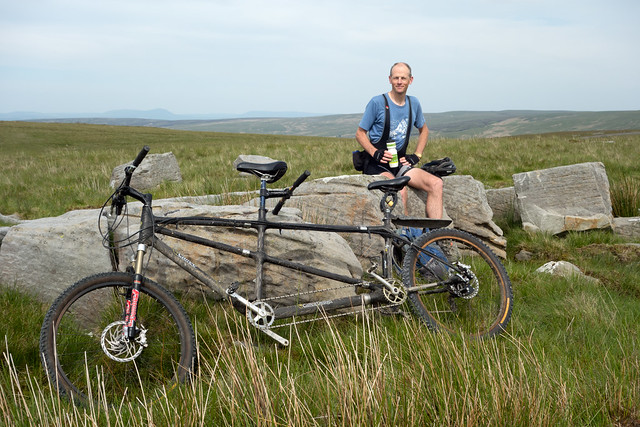
As you can see, it is almost as densely forested as Iceland. Because it is an Area of Outstanding Natural Beauty it also does not have windmills growing in it, despite being a very very windy place. The rocks are interesting. They look like they were cut into blocks by people, but I am virtually certain that they were not. However, I am not sure one should feel very certain about anything in a treeless forest.
--
Posted By Blogger to jules' pics at 6/06/2014 08:47:00 PM
13 comments:
Sheep and beef farming predominates in the uplands ...
Get rid of all of that and the forest will return.
Confusingly, you look distinctly unmoorish.
Steve,
eh?
jules
Is that a Calfee carbon tandem you're riding?
Nice!
non-Moor on moor
Mark:
Yes, this is Garth the S&S mountain/road/travel tandem. Even with a rigid fork and thin tyres, he's rather slow on the road compared to our Cannondale, but he's very fast offroad, just not quite as good at drop offs as our Ventana (yes, we have 3 tandems). But he makes up for that by being very light when you have to get off and push.
I see that Calfee are now offering stock mountain tandems, but Garth dates from the turn of the century and so is one of their "handful" of custom mtb tandems.
jules
David,
Sheep are tastier than trees. I vote for the status quo!
Mark, as jules said, this is our go-anywhere travelling tandem. A bit of an indulgence, it was originally bought with a round the world trip in mind (including this MTB race in the Rockies) and has been quite useful on a number of occasions since. We carried it with us and have been using it as a road bike up to now, but were recently reunited with our main road tandem (cannondale), and our Ventana MTB tandem is in hospital.
You are certainly paying through the nose for those sheepies:
http://www.monbiot.com/2014/03/03/the-benefits-claimants-the-goverment-loves/
Monbiot has a earlier article devoted just to the outrageous subsidies which go to those upland herders.
Eh, the forest may not have had any trees in the first place: the 'Pedia refers it to Royal forest, a hunting ground rather than a wooded area.
Shaun the sheep is innocent, probably!
Check the tree line @ that latitude. No sheep, trees up to there.
Save tax money.
Dave - royal forests for deer hunting weren't moorland, they were more like scrub or woodland. Deer like trees to hide amongst and graze off the various things growing in forests. Hence deer forests usually did have trees around, albeit not usually fully mature woodland.
Regardless of the origins of the name, it certainly would be substantially forested if not grazed - the trees grow thickly up to the fenced boundaries, and most of the land is only 3-500m above sea level.
Somewhere, I found that Royal Forests had large areas of moorland as well as wooded areas.
More specifically,
http://www.forestofbowland.com/heri_localdistinct_lhh
"the title ‘forest’ refers to hunting rights, and not to a large expanse of woodland.... Hunting in these areas was traditionally for deer and wild boar, together with rabbits, foxes, hares, pheasants and partridges. . . .
Managing the land for game hunting, primarily grouse shooting, has remained a predominant influence on the landscape . . .
Bronze Age settlers cleared trees from the fells and began cultivating the land. They left little material evidence of their presence, but the fells have remained largely clear of trees ever since."
While sheep certainly destroy saplings, so do deer and at least in upland Scotland forests have to be protected by deer fences.
So, not clear which beasts contributed to this being moorland, or indeed whether climate change causing cooler wetter uplands was part of the cause. Mainly, it seems to be down to land management.
Post a Comment